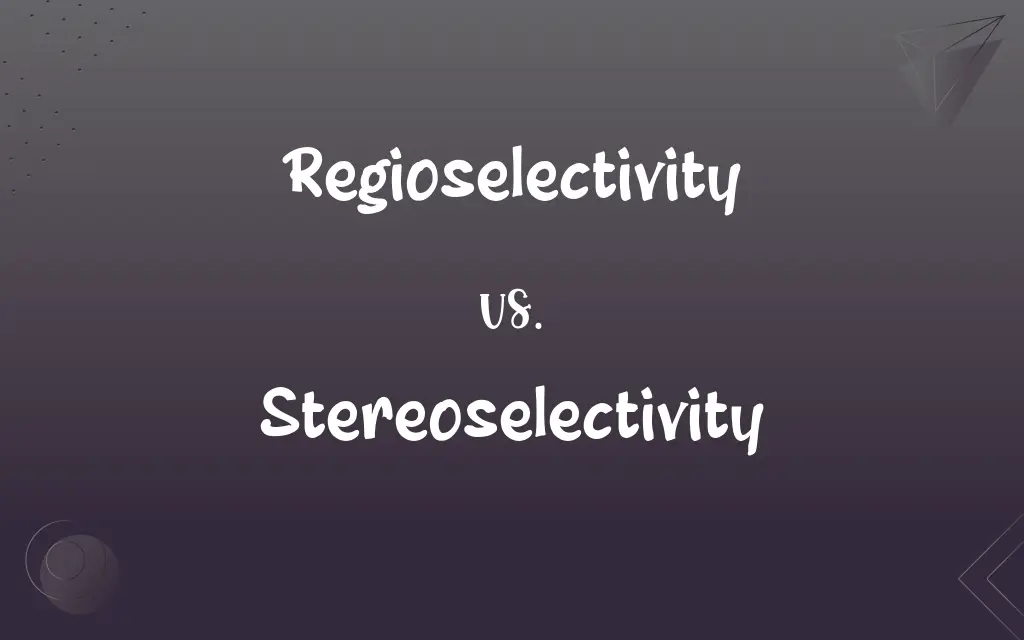Regioselectivity vs. Stereoselectivity: What's the Difference?
Edited by Aimie Carlson || By Janet White || Published on May 17, 2024
Regioselectivity is the preference for a reaction to occur at one position over others in a molecule, while stereoselectivity involves the preference for forming one stereoisomer over others.

Key Differences
Regioselectivity and stereoselectivity are concepts in chemistry that describe the preference of chemical reactions to occur in particular manners. Regioselectivity refers to the tendency of a chemical reaction to favor the formation of one structural isomer over others. This means that when a reactant can potentially yield two or more products that differ in the position of their atoms, the reaction selectively produces one product predominantly due to the inherent properties of the reactants or the conditions under which the reaction is carried out. Stereoselectivity, on the other hand, is concerned with the preference for the formation of one stereoisomer over others when a chemical reaction can yield products that are mirror images or diastereomers of each other. This selectivity is crucial in the synthesis of molecules with specific three-dimensional orientations, which can have significant implications in fields such as pharmaceuticals, where the biological activity of a compound can be highly dependent on its stereochemistry.
Regioselectivity focuses on the "where" aspect of a reaction's outcome, determining the location at which a chemical modification occurs within a molecule. This concept is pivotal in organic synthesis, where the functionalization of specific positions within a molecule can lead to vastly different chemical properties and reactivities. Stereoselectivity emphasizes the "how" aspect, detailing the geometric orientation of the atoms or groups added to or formed within the molecule during the reaction. It highlights the importance of the spatial arrangement of atoms in chemical processes and the creation of products with desired three-dimensional structures.
Both regioselectivity and stereoselectivity are fundamental to achieving specificity in chemical reactions, enabling chemists to synthesize compounds with precise structural and stereochemical configurations. These concepts are not only critical for the development of new drugs with specific biological activities but also for the design of materials with unique physical properties. Understanding and controlling regioselectivity and stereoselectivity are essential skills in organic chemistry, allowing for the tailored synthesis of complex molecules.
Comparison Chart
Definition
Preference for a reaction at a specific position in a molecule.
Preference for forming one stereoisomer over others.
Focus
Positional isomerism
Geometric or conformational isomerism
ADVERTISEMENT
Influencing Factors
Electronic and steric effects, reactant structure
Chirality, catalysts, reaction conditions
Importance
Determines the functional group's position
Determines the spatial arrangement of atoms
Applications
Organic synthesis, drug design
Pharmaceutical activity, material science
Regioselectivity and Stereoselectivity Definitions
Regioselectivity
It describes how a reaction chooses one direction of chemical bond formation over another based on the molecular structure.
The addition of HCl to an alkene exhibits regioselectivity by favoring the Markovnikov product.
Stereoselectivity
It refers to the preference in reactions leading to the selective formation of cis or trans isomers.
In the dihydroxylation of alkenes, stereoselectivity determines whether the OH groups are added syn or anti.
ADVERTISEMENT
Regioselectivity
Regioselectivity outlines the selectivity in multi-directional chemical reactions towards a particular regioisomer.
In nitration reactions, regioselectivity decides whether the nitro group attaches to the ortho, meta, or para position of a benzene ring.
Stereoselectivity
Stereoselectivity is the principle guiding the outcome of reactions to yield products with specific three-dimensional structures.
The stereoselectivity in the addition of nucleophiles to chiral aldehydes results in major and minor diastereomeric products.
Regioselectivity
It refers to the tendency of certain reactions to favor the formation of products where new bonds form at specific locations.
In the Friedel-Crafts acylation, regioselectivity is observed when the acyl group prefers the more electron-rich positions on an aromatic ring.
Stereoselectivity
It describes the tendency of a reaction to favor the formation of products with a specific spatial arrangement of their atoms.
The epoxidation of alkenes with a chiral catalyst exhibits high stereoselectivity, giving mainly one epoxide enantiomer.
Regioselectivity
Regioselectivity is the preference of a chemical reaction to occur at one specific location on a molecule rather than others.
In the hydroboration-oxidation of an alkene, regioselectivity determines the boron adds to the less substituted carbon.
Stereoselectivity
Stereoselectivity indicates the selectivity for one geometric orientation of substituents in a chemical reaction.
The stereoselectivity of E2 eliminations results in the formation of the more stable trans-alkene over the cis-alkene.
Regioselectivity
Regioselectivity is a principle that dictates the dominant pathway of a reaction based on the structural preferences of the reactants.
The regioselectivity of Diels-Alder reactions is influenced by the electron densities on the diene and dienophile.
Stereoselectivity
Stereoselectivity is the preference of a chemical reaction to produce one stereoisomer over another when multiple are possible.
In asymmetric hydrogenation, stereoselectivity leads to the predominant formation of one enantiomer over the other.
Regioselectivity
(uncountable) The condition of being regioselective.
Regioselectivity
(countable) The degree to which a reaction is regioselective.
FAQs
Can regioselectivity and stereoselectivity be controlled?
Yes, both can be controlled by adjusting reaction conditions, using specific catalysts, or modifying the reactants.
What is stereoselectivity?
Stereoselectivity is the preference of a chemical reaction to produce one stereoisomer over another.
Why is stereoselectivity significant in drug design?
Stereoselectivity is vital in drug design because the biological activity of drugs can depend on their stereochemistry.
What is regioselectivity?
Regioselectivity refers to the preference of a chemical reaction to occur at a specific position on a molecule.
What are diastereomers in the context of stereoselectivity?
Diastereomers are stereoisomers with different spatial arrangements that are not mirror images, and their formation is influenced by stereoselectivity.
What role do chiral catalysts play in stereoselectivity?
Chiral catalysts control stereoselectivity by providing an environment that favors the formation of one stereoisomer.
How do electronic effects influence regioselectivity?
Electronic effects influence regioselectivity by directing reactions to occur at positions with specific electronic characteristics, such as electron density.
Why is regioselectivity important in organic synthesis?
Regioselectivity is crucial for directing the formation of specific products from potentially complex mixtures.
What is Markovnikov's rule in regioselectivity?
Markovnikov's rule predicts the outcome of addition reactions to alkenes, where the electrophile adds to the carbon with fewer substituents.
Can temperature influence regioselectivity?
Yes, temperature can influence regioselectivity by affecting the kinetics of different reaction pathways.
How does steric hindrance affect regioselectivity?
Steric hindrance affects regioselectivity by preventing reactions at crowded or less accessible positions on a molecule.
Can a reaction be both regioselective and stereoselective?
Yes, many reactions are both regioselective and stereoselective, producing specific isomers both in terms of position and spatial arrangement.
How do solvent effects impact stereoselectivity?
Solvent effects impact stereoselectivity by influencing the transition state and stabilizing certain stereoisomers over others.
How does the nature of the substrate affect regioselectivity?
The nature of the substrate, such as its electronic and steric properties, significantly affects regioselectivity by influencing the reaction pathway.
Can regioselectivity be predicted?
Regioselectivity can often be predicted based on the electronic and steric properties of reactants and the mechanism of the reaction.
What is enantioselectivity?
Enantioselectivity is a type of stereoselectivity where the reaction prefers one enantiomer over the other.
Does pressure have an effect on stereoselectivity?
Pressure can have an effect on stereoselectivity, especially in reactions where volume changes significantly influence the transition state.
How is stereoselectivity measured?
Stereoselectivity is measured by determining the ratio of stereoisomers formed in a reaction, often using spectroscopic methods.
What factors can override stereoselectivity in a reaction?
Factors like the use of a more powerful chiral director or extreme reaction conditions can override the inherent stereoselectivity of a reaction.
What is the role of reaction mechanism in determining regioselectivity?
The reaction mechanism plays a crucial role in determining regioselectivity by dictating how and where bonds are formed or broken.
About Author
Written by
Janet WhiteJanet White has been an esteemed writer and blogger for Difference Wiki. Holding a Master's degree in Science and Medical Journalism from the prestigious Boston University, she has consistently demonstrated her expertise and passion for her field. When she's not immersed in her work, Janet relishes her time exercising, delving into a good book, and cherishing moments with friends and family.
Edited by
Aimie CarlsonAimie Carlson, holding a master's degree in English literature, is a fervent English language enthusiast. She lends her writing talents to Difference Wiki, a prominent website that specializes in comparisons, offering readers insightful analyses that both captivate and inform.






































































